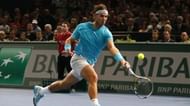Nadal needs to work on his backhand. His recent losses hint that somehow the unsolvable Nadal-mystery-code has been finally decrypted – push him outside the court by serving at his backhand and opening up the court for a down the line forehand winner, a tactic so effectively pioneered by Djokovic. This has now implicitly become a blueprint of sorts for those looking to dislodge the champion from his comfort zone.
Of course, a player needs to be dead accurate with his serve, precise in his shot selection, deep in his return and must observe an enormous cut-down on his unforced errors in order to fancy his chances against the Spaniard. He must look to frustrate Nadal, to make him try something different, to compel him to make further errors and at the same time try to stretch him farther away from the baseline, forcing him back into his signature defensive mode from the offensive mode.
All of these tactics were executed to perfection by David Ferrer last night at Paris and were rewarded handsomely. Make no mistake, Nadal’s all three losses on hardcourts this year have been straight-set defeats – a huge matter of concern for his team. Nadal was dominated on all the three occasions and this time by his compatriot who he hadn’t lost to in more than two years.
Although David must be applauded for finally overcoming the Goliath, Nadal seems to be falling prey to a certain strategy over and again and that is what disturbs me. He should regroup and work more on his backhand, especially the one down the line, and try to hit deeper and wider with the same. The consistency with which he held his serve, saved break points and hit backhand winners were the major ingredients of his astonishing run on hardcourts this year. The variety in his serve, apparent for most part of this year, has been somewhat diminishing of late.
Now, Nadal has never been good with aces. In fact, Nadal ranks 58th in the ATP service games won ranking, and has hit merely 197 aces in 72 matches this year compared to 940 by John Isner and 415 by his rival Djokovic. Aces allow a player to earn easy points and unfortunately that’s missing from Nadal’s already overflowing arsenal. Nadal has to work hard to win points on his serve. Those who know him best are accustomed to seeing him leap and sprint all around the court, chasing every ball, trying to put everything hurled at him back into the court.
Apart from his acrimony with aces, Nadal’s game-play is further wounded by the absence of winners. Nadal relishes indulging in rallies rather than opting for winners and cutting short the points, all the while restraining the unforced errors and tempting his opponents to go for the kill and eventually fall short, thus enabling him to gain control of the match. If his opponent manages to cut down on his unforced errors, he has to match the precision of Nadal’s striking ability which is of the highest order and in the face of which defeat again becomes almost inevitable.
But top players like Novak, Roger, Andy, David and del Potro, with their incredible hitting prowess, can very much indulge in healthy competition with Nadal and fancy their chances as well. Yes, it’s nearly impossible to beat him on clay, and riding on his impeccable form this season Nadal would be more at ease with himself than his peers. The fact that he is able to reach as far as the semis on his weakest surface speaks volumes of his incredible form. Yet as fans, we can only crave for more.
The season ending World #1 ranking seems almost inevitable but a win at the World Tour Finals against the very best of the world on his most despised surface would certainly serve as an icing on the cake and reignite the recurring GOAT debates between the veterans and experts of the game.
For the most part of his career tennis has been synonymous with Federer. The Swiss redefined the sport with his artistic swings, traditional serve and volley, majestic forehand winners and trademarked tweener. What Nadal brought to the game was athleticism. Sprinting from one end of the court to the other, the baffling banana shot, running forehand winners – they all bear testament to his infallible defence and immense mental strength. Federer made the game look beautiful and gentle, Nadal brought ruthlessness to it. His self-belief met with success is the greatest spectacle to behold in all of tennis and a rich source of inspiration for people all over.
Nadal has been down and out before, his knees forcing him out of competition on numerous occasions; he battles while struggling with pain, he chases, he slips, slides, he relinquishes. But he never surrenders, he never backs out. At one moment he’ll appear completely outplayed, the next he’d be dancing across the court hitting an improbable running forehand down the line winner. Just like he did this year when the experts questioned his place in this renaissance phase for tennis. Just like he defeated Djokovic thrice in a row after losing seven straight finals. The bitter truth – there might be a place on this earth where you can’t defeat Nadal but you can’t be sure anywhere else that he can’t defeat you.
The bottom line is that as long as Nadal stands on the other end of the court, there is just one favourite and that is him! That’s why he is my favourite player and that’s why the deafening shouts of ‘VAMOS!’ envelope the entire arena whenever he’s on out on the court.
What is the foot injury that has troubled Rafael Nadal over the years? Check here
